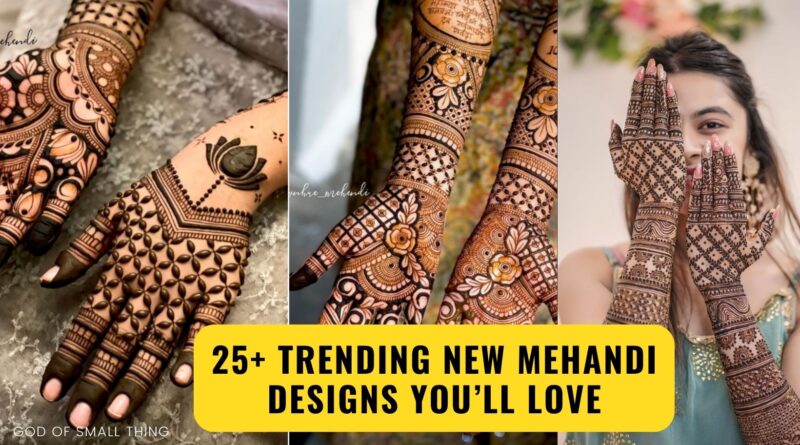25+ Trending New Mehandi Designs You’ll Love
Imagine when your hands and feet become canvases and are transformed into living masterpieces that tell stories of culture and celebration. That’s the enchanting realm of mehndi, better known as henna, where the scent of crushed henna leaves carries with it the magic of centuries past. It’s a world where every stroke of a henna cone weaves a unique tale, connecting you to an ancient art form that dances at the intersection of beauty and tradition. Mehndi, often associated with weddings, festivals, and special occasions, goes far beyond just pretty mehandi designs. It’s a universal language that transcends borders, speaking of heritage, rituals, and the bonds that tie us together as humans. These New Trending Mehandi Designs will make your occasion even more special for sure.
As you sit down to have your hands adorned with mehndi, you’re not just embracing a moment of visual splendour; you’re partaking in living history that’s as vibrant and diverse as the patterns themselves. Mehndi is a reminder that beauty and tradition can go hand in hand, leaving an indelible mark not just on your skin, but on your heart as well. Here we present you 25+ Trending New Mehandi Designs You’ll fall in love with and can’t wait to try them on! So, here we go.
1. Traditional Indian Bridal Mehndi Design
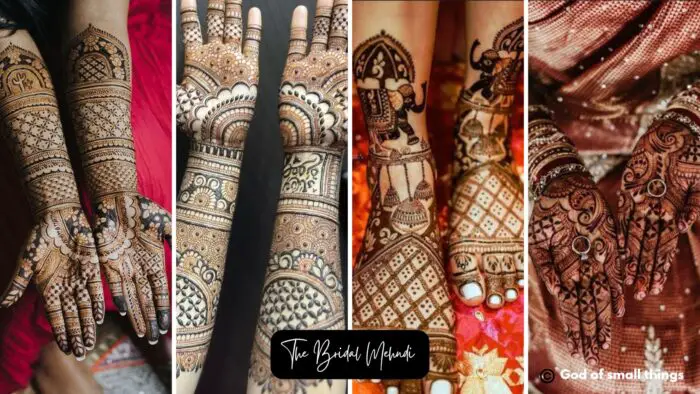
Mehndi holds immense cultural significance in Indian weddings, symbolizing love, prosperity, and the union of two souls. The bridal mehndi involves skilled artisans who meticulously apply intricate designs to the bride’s hands and feet. These designs often incorporate traditional motifs like Paisleys. Paisley motifs are a hallmark of traditional Indian mehandi designs.
They are often used as central elements in bridal mehndi, representing fertility and good luck. Various types of flowers like lotus, roses, and marigolds are commonly incorporated into mehndi patterns, symbolizing beauty, love, and happiness. Peacock motifs are a classic feature of Indian mehndi, denoting grace and beauty. These elaborate birds are often intricately detailed in the designs. Bridal mehndi often includes symbols specific to weddings, such as the bride and groom’s figures, wedding bells, and ceremonial elements like the “doli”. Each element carries its unique symbolism.
In recent years, the bridal mehndi industry has witnessed a fusion of styles, as brides opt for contemporary patterns alongside classic ones. Traditional Indian mehndi designs showcase the rich heritage and symbolism of Indian culture through beautiful handcrafted artistry.
2. Arabic mehndi with bold floral patterns Mehandi Designs

Characterized by its bold, oversized floral motifs and minimalist approach, Arabic mehndi stands out for its simplicity and grace. These designs often feature large roses, lotuses, or peonies as their focal points, with thick, dark lines that create a striking contrast against the skin. The bold floral elements are complemented by intricate leaves, vines, and geometric patterns that flow gracefully across the hands and arms.
Arabic mehandi designs frequently include decorative wrist cuffs, which can be quite elaborate and may feature geometric patterns or additional floral elements. One of the defining features of Arabic mehndi is the strategic use of negative space, which allows the bold patterns to shine while maintaining a sense of balance and openness in the design. Arabic mehndi designs are popular for their versatility and suitability for various occasions. They are particularly favoured for their ability to complement a wide range of outfits and styles, making them a popular choice for weddings, festivals, and celebrations across the Middle East and beyond.
3. Moroccan-inspired geometric mehandi
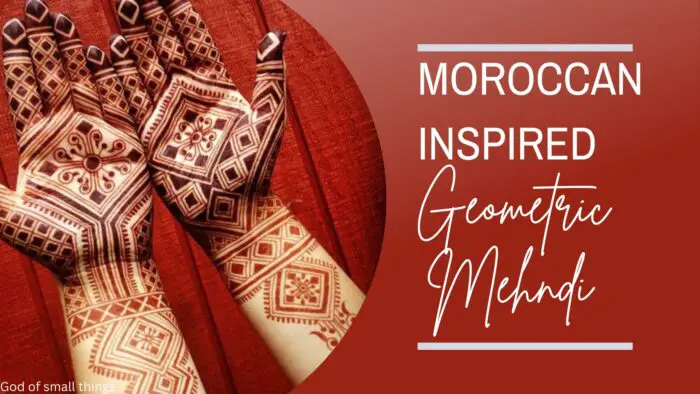
The hallmark of Moroccan geometric mehndi lies in its use of triangles, squares, diamonds, and hexagons, meticulously arranged to create stunning latticework and ornate borders that frame the hands and feet. Symmetry is a key element of Moroccan-inspired mehndi. Designs are typically mirrored on both hands or feet, creating a harmonious and balanced appearance.
This style of mehndi is a testament to the mathematical precision and artistic finesse inherent in Moroccan design traditions. The striking contrast between the dark henna stain and the intricate geometric patterns adds to the visual allure, making Moroccan geometric mehndi a sought-after choice for those who appreciate the fusion of art, culture, and timeless beauty in their henna designs. Whether for weddings, festivals, or simply as an expression of artistic flair, Moroccan-inspired geometric mehndi continues to captivate with its mesmerizing symmetries and intricate detailing.
4. Peacock-themed mehandi design
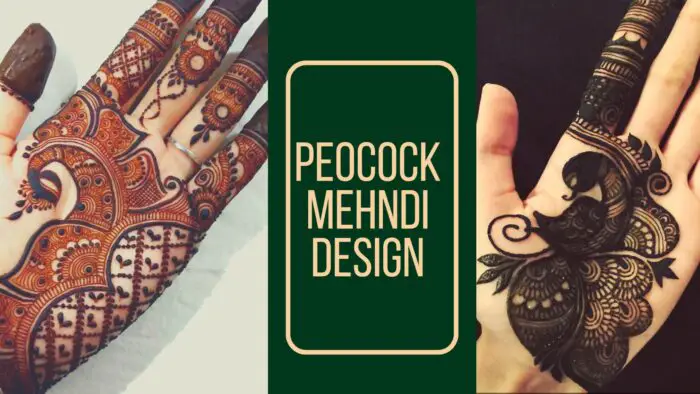
Peacock-themed mehandi designs are a captivating and popular choice among brides and henna enthusiasts alike. These intricate patterns draw inspiration from the elegant and vibrant peacock, known for its strikingly beautiful plumage. In such designs, the mehndi artist skillfully incorporates peacock motifs, feathers, and even the bird’s graceful silhouette into intricate henna patterns.
The peacock’s rich symbolism adds depth to these designs, as it represents beauty, grace, and love in various cultures. The focal point of a peacock-themed mehndi design often centres around the bride’s hands or feet, where the intricate details of the peacock’s feathers come to life. The feathers are meticulously adorned with swirls, dots, and paisley motifs, creating a mesmerizing tapestry of artistry. Peacock-themed trending mehndi designs are not limited to brides alone; they are also chosen for various festive occasions and celebrations. With their blend of tradition and aesthetics, these designs continue to capture hearts and inspire awe, making them a timeless choice in the world of henna artistry.
5. Rajasthani Mehndi: Intricate Beauty

Rajasthani Mehndi, renowned for its intricate and timeless designs, holds a special place in Indian cultural heritage. Hailing from the majestic state of Rajasthan, this form of mehndi art is a reflection of the region’s rich traditions and royal aesthetics. What sets Rajasthani mehndi apart is its elaborate patterns, characterized by fine lines, floral motifs, and exquisite detailing.
It often features peacocks, elephants, and the depiction of the bride and groom, symbolizing love and harmony. The mehndi paste used in Rajasthani designs is made from natural ingredients, lending a deep, reddish-brown hue to the final artwork.
One of the hallmarks of Rajasthani Mehndi is its painstaking craftsmanship. Skilled artisans employ intricate shading techniques to create depth and dimension within the designs.
The motifs are often intertwined to form a seamless tapestry of artistry that adorns the hands and feet of brides and women during festive occasions. Rajasthani mehndi embodies the spirit of Rajasthan, with its vibrant culture and royal grandeur, making it a cherished part of weddings and celebrations across India and beyond. Its timeless beauty and attention to detail continue to captivate admirers, making it a revered art form that transcends generations.
6. Minimalist mehndi with simple patterns
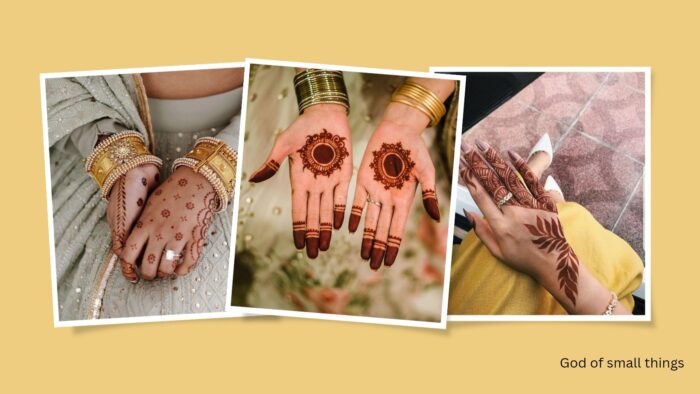
Minimalist mehndi, a contemporary take on traditional henna art, celebrates the beauty of simplicity. This style embraces clean lines, geometric shapes, and uncomplicated patterns, setting it apart from the more intricate stylish mehndi designs. Characterized by its understated elegance, minimalist mehndi appeals to those who prefer a subtle yet graceful adornment.
It often features minimalist floral motifs, delicate vines, and straightforward geometric elements, resulting in a design that is both chic and versatile. What makes minimalist mehndi so appealing is its versatility and suitability for various occasions. It can be applied in a way that complements modern attire and casual gatherings, as well as more formal events like weddings.
The clean and uncluttered look of minimalist mehndi not only enhances the beauty of one’s hands and feet but also allows for a quicker application process compared to the intricate styles. This style has gained popularity among individuals seeking a mehndi design that is refined, contemporary, and easy to maintain, making it a choice that continues to charm and captivate enthusiasts worldwide.
7. Glitter mehndi for sparkle Mehandi Design
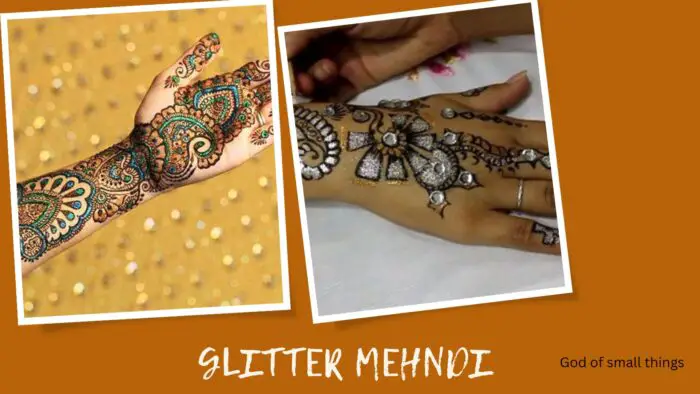
Glitter mehndi, a dazzling and contemporary twist on the traditional art of henna, has taken the world of body adornment by storm with its mesmerizing sparkle. This artistic fusion blends the centuries-old practice of adorning hands and feet with intricate henna designs with the modern allure of shimmering glitter. Typically applied in vibrant colours such as gold, silver, or iridescent shades, glitter mehndi adds a touch of glamour to traditional celebrations like weddings and festivals.
The fine henna patterns serve as a base for the glitter, creating a harmonious contrast between the organic intricacy of the henna and the brilliant allure of the glitter. The result is a stunning fusion of tradition and modernity that captivates the eye and adds an extra layer of opulence to any special occasion.
Glitter mehndi offers a versatile canvas for self-expression, allowing individuals to customize their designs with intricate patterns, florals, and geometric motifs, all aglow with glittering brilliance.
Moreover, it appeals to a diverse audience, transcending cultural boundaries and becoming a popular choice for brides and party-goers alike. Whether one opts for a subtle sprinkle of glitter or an all-out radiant extravaganza, glitter mehndi undoubtedly adds a unique sparkle to life’s most cherished moments, making it a glamorous trend that continues to shine bright on the global stage of beauty and adornment.
8. Indo-Arabic fusion mehndi

Indo-Arabic fusion mehndi is a captivating and unique form of body art that beautifully blends the intricate patterns of traditional Indian mehndi with the elegance and grace of Arabic design elements. This exquisite style of henna application has gained immense popularity in recent years, especially in weddings and special celebrations, where it adds a touch of cultural diversity and sophistication.
In Indo-Arabic fusion mehndi, you’ll often find a harmonious amalgamation of bold and intricate floral motifs from Indian mehndi combined with the fluidity and geometric patterns characteristic of Arabic art. These designs typically cover the hands and feet, extending into intricate and flowing patterns that captivate the eye.
The fusion of Indian and Arabic styles creates a mesmerizing tapestry of culture and aesthetics, resulting in mehndi that is not only visually stunning but also rich in symbolism. It serves as a symbol of the union of two cultures or two individuals and is a testament to the beauty of diversity in celebrations. Whether you’re a bride looking to adorn yourself on your special day or simply someone who appreciates the artistry of mehndi, Indo-Arabic fusion mehndi offers a truly enchanting choice.
9. Lotus Flower Mehandi Designs
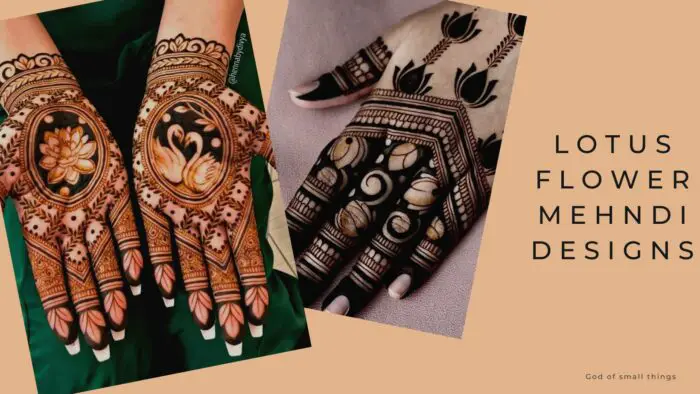
Lotus flower stylish mehndi designs hold a special place in the world of henna artistry, renowned for their profound symbolism and exquisite beauty. The lotus, a revered symbol in various cultures, represents purity, enlightenment, and spiritual awakening. When intricately woven into mehandi designs, the lotus blossom adds a touch of elegance and depth. These designs often feature the lotus in different stages of bloom, each representing a unique aspect of life’s journey. The tightly closed bud signifies potential and resilience, while the fully bloomed flower symbolizes enlightenment and self-realization.
This progression is thoughtfully incorporated into the mehndi patterns, creating a narrative that captivates both the wearer and those who admire the art.The allure of lotus flower mehandi designs lies not only in their symbolism but also in their aesthetic appeal. Henna artists meticulously craft the lotus petals, using fine lines and intricate detailing to capture the flower’s delicate beauty. These designs can be incorporated into various mehndi patterns, from traditional bridal designs to contemporary body art.
The lotus’s soft, flowing contours lend themselves well to Mehndi’s organic and flowing style, making it a versatile choice for henna enthusiasts. Whether chosen for its profound meaning or its visual appeal, the lotus flower mehndi design continues to be a timeless and enchanting choice in the world of henna art.
Have to go to a retro-look theme party? Or want to try out some classic Bollywood retro looks? Here are 25+ Best Bollywood retro outfit ideas to go for
10. Floral vines and leaves mehndi
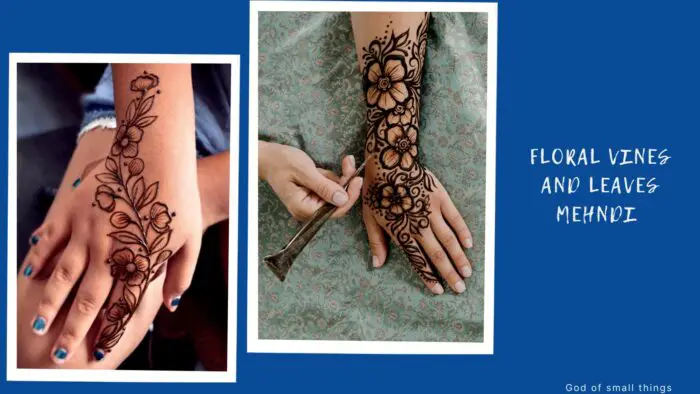
Floral vines and leaves stylish mehndi designs are a captivating and timeless form of body art that traces its origins back to ancient traditions in India and the Middle East. These intricate designs feature an abundance of delicately drawn vines, leaves, and flowers, which are typically applied using henna paste. The natural reddish-brown stain produced by henna lends a beautiful, earthy tone to the skin, making it a popular choice for adorning hands and feet during special occasions like weddings, festivals, and celebrations.
The allure of floral vines and leaves mehndi lies in its versatility and symbolism. Vines symbolize growth, harmony, and interconnectedness, while leaves and flowers are often chosen for their representation of nature’s beauty and renewal.
The interplay of these elements in mehandi designs results in breathtaking patterns that can be tailored to suit various preferences and occasions. Whether it’s the bridal mehndi adorning a bride’s hands on her wedding day or the intricate patterns adorning the hands of festival-goers, floral vines and leaves mehndi continue to be a cherished and intricate form of self-expression and celebration.
11. Mandala inspired Mehndi patterns

Mandala-inspired Mehndi patterns are a captivating fusion of two ancient art forms, originating from different parts of the world. Mehndi, also known as henna tattooing, has its roots in South Asia, where intricate designs are applied to the skin using a paste made from the henna plant. Mandalas, on the other hand, trace their origins to various cultures, including Hinduism and Buddhism, and are geometric, symmetrical patterns often representing the universe or unity.
The combination of these two artistic traditions results in mesmerizing designs that carry profound cultural and spiritual significance.
In Mandala-inspired Mehndi, the circular and symmetrical nature of mandalas is delicately incorporated into Mehndi patterns, creating a harmonious blend of form and flow.
These designs often feature a central point, radiating outward with intricate details, giving a sense of balance and completeness. Beyond their aesthetic appeal, these patterns can hold deep symbolism, reflecting themes of unity, spirituality, and interconnectedness. When adorned on the skin, Mandala-inspired Mehndi patterns not only serve as a form of body art but also as a means of expressing one’s inner connection with the cosmos and embracing the rich heritage of both Mehndi and mandala traditions.
12. Bracelet style mehndi on wrists
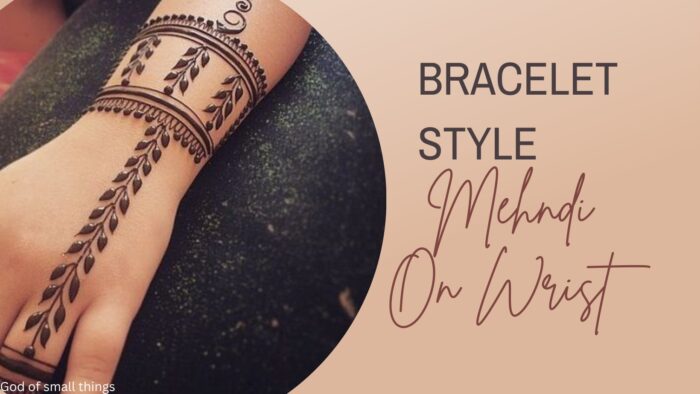
Bracelet-style mehndi, also known as henna bracelets, is a popular and elegant form of mehndi artistry that adorns the wrists with intricate and delicate designs. This style of mehndi involves the application of henna paste in patterns that mimic the appearance of ornate bracelets, creating a stunning and temporary accessory. These wrist designs are often characterized by their fine detailing, incorporating motifs such as paisleys, vines, floral elements, and geometric patterns. The mehndi artists skillfully use their creativity and dexterity to craft these designs, which can range from simple and subtle to elaborate and extravagant, depending on personal preference.
Bracelet-style mehndi is a favored choice for various occasions, including weddings, festivals, and special celebrations. It not only enhances the beauty of the wrists but also holds cultural significance in many regions. The temporary nature of henna tattoos allows individuals to experiment with different designs and styles without the long-term commitment of permanent tattoos. Additionally, the natural reddish-brown hue of henna complements a wide range of skin tones, making it a versatile and timeless choice for those seeking to add a touch of elegance and tradition to their wrists.
Are you somebody who likes to bleach but has sensitive skin? Well if you are one of them, here is something that can help! Top 10 Bleach Creams for Sensitive Skin
13. Mehndi with intricate lace or net patterns
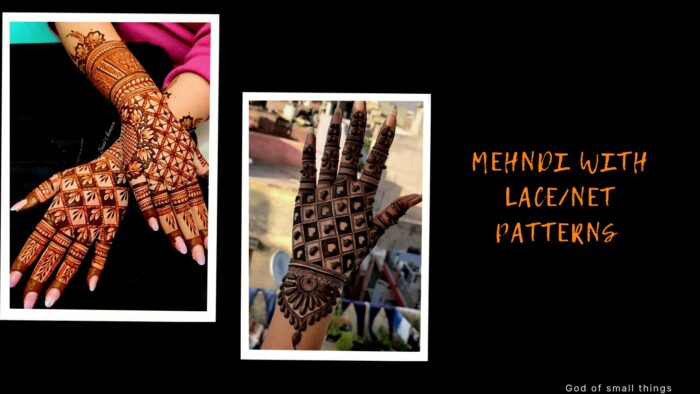
Mehndi, also known as henna art, has a rich tradition of adorning hands and feet with intricate lace or net patterns. This form of body art dates back centuries and is deeply rooted in various cultures, particularly in South Asia and the Middle East. One of the most captivating aspects of mehndi is its ability to weave delicate lace-like designs onto the skin using a paste made from finely ground henna leaves.
These lace patterns often feature intricate floral motifs, paisleys, and geometric shapes meticulously crafted by skilled henna artists. The allure of lace or net-inspired mehndi lies in its elegant and timeless appeal. The fine, lacy details are created by applying henna paste in a precise manner, resulting in a mesmerizing play of negative space against the rich, reddish-brown stain of the henna. This form of mehndi is especially popular at weddings and festivals, where brides and celebrants showcase their hands and feet adorned with these exquisite designs. The delicate patterns not only symbolize beauty but also represent the intricate tapestry of life’s moments, making lace-inspired mehndi a cherished art form that continues to captivate and inspire people across the globe.
14. Paisley Mehndi
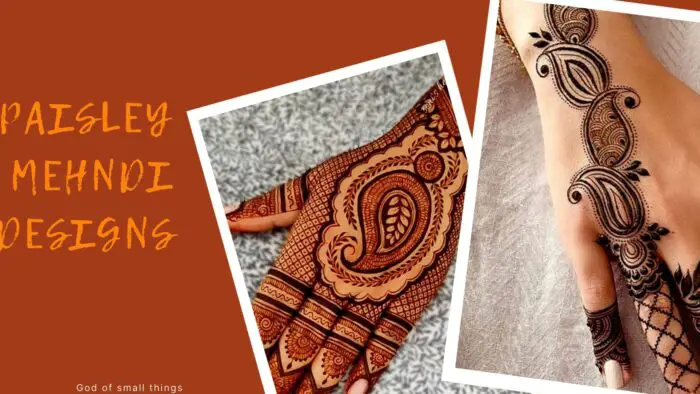
Paisley Mehndi motifs, often referred to as “buta” or “boteh,” are a timeless and intricate design element deeply rooted in the rich tradition of Mehndi art. These motifs are characterized by their teardrop or kidney-shaped patterns, which are meticulously hand-drawn with henna paste on the skin. Originating in Persia, paisley motifs have transcended cultural boundaries and have become an integral part of henna artistry in various parts of the world.
The beauty of paisley Mehndi motifs lies in their versatility.
These elegantly curved shapes can be incorporated into a myriad of designs, from delicate wristbands to elaborate bridal patterns. Paisley motifs symbolize fertility, luck, and eternity in many cultures, making them a popular choice for brides during their wedding ceremonies. As the henna paste dries and leaves behind a rich, reddish-brown stain on the skin, the paisley motifs come to life with a timeless allure, making them a cherished and meaningful adornment for special occasions and celebrations.
15. Finger ring style mehndi
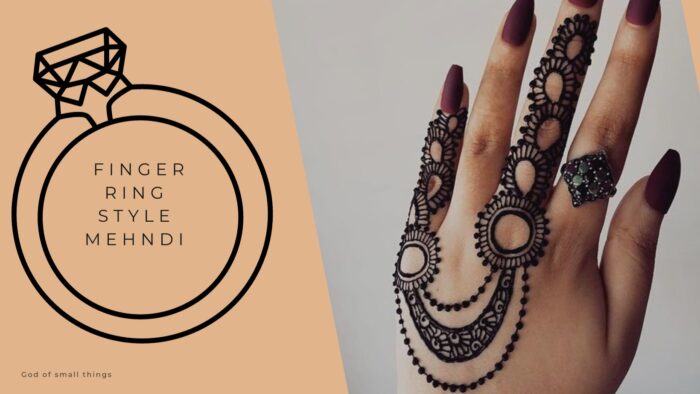
Finger ring style mehndi is a contemporary and creative variation of traditional henna art that has gained popularity in recent years. This intricate design involves the application of henna in a way that mimics the appearance of delicate finger rings and jewelry. Typically, it starts at the base of the finger and extends to cover a portion of the finger, resembling ornate rings adorned with intricate patterns.
This style of mehndi is a perfect choice for those looking to add a touch of elegance and uniqueness to their hand adornments, especially for special occasions like weddings and festivals.
What sets finger ring style mehndi apart is its versatility. Artists can tailor the design to suit various preferences, from minimalist and dainty patterns to more elaborate and elaborate designs with floral motifs, paisleys, or even personalized elements. The result is a striking and eye-catching accessory that enhances the overall beauty of the hands. Finger ring mehndi is not only a beautiful form of self-expression but also a meaningful tradition that symbolizes celebration, love, and cultural heritage.
16. Bridal mehndi with groom’s name on it

Bridal mehndi, a cherished tradition in many cultures, is a captivating art form that adorns a bride’s hands and feet with intricate henna designs, symbolizing beauty, love, and the anticipation of marriage. As the bride sits patiently, the skilled mehndi artist weaves delicate patterns that tell a unique story. Hidden within these elaborate designs, one can often find the groom’s name subtly incorporated, adding an element of surprise and romance to the overall symbolism.
This discreet inclusion of the groom’s name is a sentimental touch, signifying the bond between the couple and their shared journey towards a lifetime of love and commitment. The artistry of bridal mehndi goes beyond aesthetics; it also carries cultural significance. In many cultures, mehndi represents the blessings of joy and prosperity that the bride’s family wishes upon her.
As the henna dries and the designs deepen in color, the bride eagerly awaits the moment when her groom will search for his name within the patterns. This playful tradition fosters a sense of excitement and connection between the couple, underscoring the profound commitment they are about to embark upon as they begin their married life together. Bridal mehndi, with the groom’s name discreetly woven into its intricate beauty, encapsulates the essence of love, tradition, and anticipation that surround a wedding day.
17. Peacock feather and paisley combo mehndi design

Combining peacock feathers and paisley motifs in mehandi designs creates a stunning and culturally rich aesthetic design that has captivated people for generations. The intricate details of a peacock feather, with its iridescent hues and elegant patterns, make it a symbol of beauty and grace. When incorporated into mehndi designs, the delicate lines and curves of the feather’s eye-catching plume add an element of sophistication and allure to the overall look.
Paired with the timeless paisley motif, which is a symbol of fertility and eternity in many cultures, this combo mehndi design not only showcases the artist’s skill but also carries deep cultural significance. The paisley pattern, known as “buta” in some regions, complements the peacock feather beautifully, enhancing the design’s intricacy and balance. This combination often graces the hands and feet of brides during weddings, symbolizing love, prosperity, and the promise of a lasting union.
The blend of peacock feathers and paisley motifs in mehndi design is a testament to the rich heritage of Indian and Middle Eastern artistry. It continues to be a beloved choice for those seeking a mehndi design that exudes both elegance and cultural symbolism, making it a timeless favorite in the world of henna art.
18. Shaded Mehndi with gradient effects
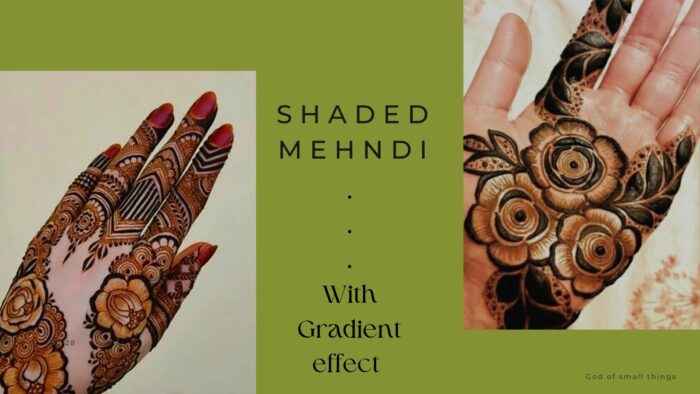
Shaded Mehndi with gradient effects is a captivating form of henna art that combines traditional mehndi patterns with modern techniques. This style involves creating intricate designs using henna paste and then adding depth and dimension through gradient shading. Here are two paragraphs describing this beautiful art form: Shaded Mehndi, adorned with gradient effects, is a mesmerizing fusion of age-old tradition and contemporary artistry.
This unique approach to applying henna elevates the classic Mehandi designs to a whole new level of sophistication. Craftsmen meticulously draw intricate patterns using henna paste, as they have for centuries, but the magic happens when they introduce gradients. By skillfully varying the pressure and density of the henna application, artists create a seamless transition of color, lending depth and dimension to the design. This results in an awe-inspiring visual effect that seems to dance on the skin, catching the light and drawing the eye into its enchanting labyrinth.
The gradient shading in Shaded Mehndi not only adds a sense of three-dimensionality but also brings a contemporary twist to this ancient art form. These gradients can be subtle and soft, creating an ethereal and delicate appearance, or bold and striking, making a strong statement. Whether it’s delicate floral motifs fading from dark to light or geometric patterns merging seamlessly into a burst of colors, the beauty of shaded Mehndi lies in its ability to surprise and captivate. It’s a testament to the enduring appeal of henna art, continually evolving to enchant new generations with its ever-creative techniques.
19. Intricate Palm Mehndi Art

Intricate Mehndi motifs on the palm are a captivating and time-honoured tradition in many cultures, particularly in South Asia and the Middle East. These delicate and ornate designs are crafted using henna paste, creating a temporary but stunning work of art on the hand’s canvas. The palm, with its broad and smooth surface, serves as an ideal canvas for the intricate patterns that range from traditional paisley and floral motifs to geometric shapes and intricate lattice-like designs. Each motif is meticulously drawn, often by skilled Mehndi artists, using a fine-tipped applicator or cone, allowing for precise detailing that transforms the hand into a mesmerizing masterpiece.
The significance of these intricate palm motifs extends beyond mere aesthetics. Mehndi, also known as henna, has cultural and symbolic value in various traditions. It is commonly applied during weddings, festivals, and other celebrations as a symbol of joy, beauty, and auspiciousness. Additionally, these motifs often carry hidden meanings and personal significance, as they can be customized to include symbols or initials that hold sentimental value for the wearer. Overall, the intricate Mehndi motifs on the palm serve as a beautiful form of self-expression, connecting individuals to their cultural roots while showcasing the artistry and craftsmanship of the Mehndi tradition.
20. Jali Mehandi designs

Jali Mehandi designs, also known as lattice or mesh patterns, are an intricate and captivating form of henna art that adorn the fingers with a delicate, lace-like appearance. These designs involve the creation of finely detailed geometric shapes, floral motifs, or abstract patterns that mimic the look of lace gloves or delicate jewelry on the skin. The artist skillfully weaves a web of lines and dots, leaving empty spaces to form the intricate jali effect. This style of Mehndi is particularly popular for brides and special occasions, as it exudes elegance and sophistication.
The jali mehndi design on fingers often extends from the tip of the finger to the wrist, creating a seamless and enchanting adornment. Jali Mehndi’s designs are not only aesthetically pleasing but also hold cultural significance. They are often symbolic of a sense of unity and interconnectedness, much like the interwoven threads of a lattice.
These intricate patterns represent the delicate balance and harmony in life, making them a meaningful choice for weddings and other significant celebrations. When applied to the fingers, jali mehandi designs add a touch of grace and allure to the hands, enhancing the overall beauty of the wearer’s hands. Whether it’s a traditional ceremony or a modern event, jali mehndi designs on fingers continue to be a timeless choice for those seeking to elevate their hand adornment to a new level of artistry and elegance.
21. Arabic-inspired finger mehndi
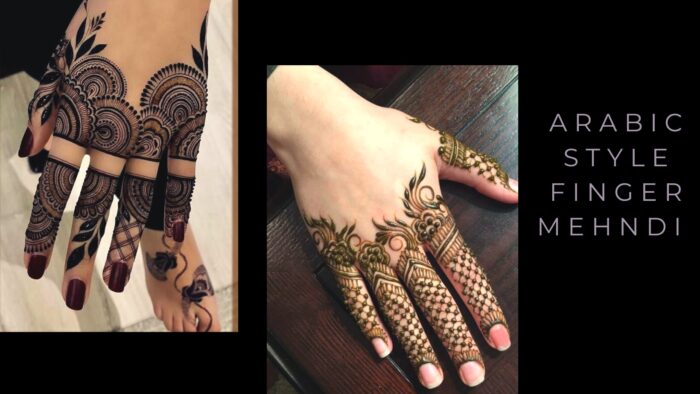
Arabic-inspired finger mehndi, also known as henna art, is a captivating form of temporary body decoration deeply rooted in Middle Eastern culture. What distinguishes Arabic finger mehndi from other henna designs is its elegant simplicity and emphasis on fine, intricate patterns. Typically applied during celebrations, such as weddings, Eid, or other special occasions, Arabic finger mehndi adds a touch of grace and allure to the hands and fingers of those who embrace it.
Arabic finger mehndi designs often feature floral motifs, geometric patterns, and delicate lace-like details that gracefully adorn the fingers and hands.
These designs are characterized by their free-flowing nature, with open spaces that allow the skin to peek through, creating a visually stunning contrast between the henna and the skin. The artistry and skill behind Arabic finger mehndi have made it a beloved tradition, not only in the Middle East but also around the world, where people appreciate its timeless beauty and cultural significance. Whether it’s for a bride on her wedding day or anyone seeking to enhance their hands’ aesthetic appeal, Arabic finger mehndi continues to be a mesmerizing and cherished form of self-expression and celebration.
22. Heart-Shaped Mehndi Patterns Mehandi Designs
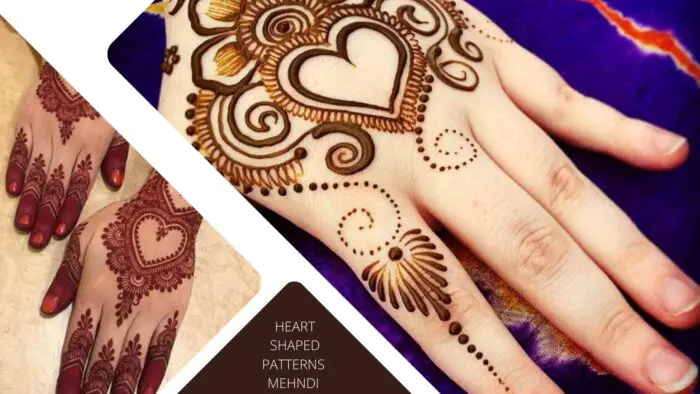
Heart-shaped Mehndi patterns are a delightful and romantic addition to the world of henna artistry. These intricate designs incorporate the iconic heart symbol, symbolizing love, affection, and passion. Often applied during weddings, engagements, or anniversaries, heart-shaped Mehndi patterns serve as a beautiful expression of deep emotional connections.
The delicate curves and fine lines of the heart create a mesmerizing visual appeal, drawing attention to the hands or feet where they are meticulously crafted. The versatility of heart-shaped Mehndi patterns allows for personalization and creativity. Artists can embellish them with various elements such as flowers, vines, or geometric patterns, further enhancing their beauty. These designs can be both traditional and contemporary, appealing to a wide range of preferences. Whether as a standalone motif or integrated into a larger Mehndi design, heart-shaped patterns continue to be a symbol of love and affection, leaving a lasting impression on those who admire them.
23. Glitter ombré mehndi

Glitter ombré mehndi is a captivating and contemporary twist on the traditional art of henna tattooing. This striking technique combines the age-old practice of applying intricate henna designs with the shimmer and allure of glitter. The result is a stunning and eye-catching mehndi style that has gained popularity in recent years, especially at weddings, festivals, and other celebratory occasions. The process involves the skilled application of henna paste in a gradient or ombré pattern, which creates a subtle transition of colour from dark to light or vice versa.
Once the henna dries and flakes off, it leaves behind a temporary stain on the skin, while the glitter accents add a touch of glamour and sparkle. Glitter ombré mehndi beautifully merges tradition with modern aesthetics, making it a popular choice among those seeking a unique and radiant mehndi design. This dazzling fusion of henna and glitter offers versatility in design and colour options.
Brides often opt for glitter ombré mehndi to complement their bridal attire, with the glitter elements matching the hues of their wedding ensemble. The shimmering effect of the glitter enhances the elegance and allure of the overall look. Moreover, this style allows for creativity to flourish, as intricate patterns and motifs can be combined with the ombré effect to create a mesmerizing and personalized mehndi design. Glitter ombré mehndi has become a captivating way for individuals to express their individuality and celebrate special moments, leaving a temporary but lasting impression of beauty.
24. Meaningful Mehndi with symbols or motifs

Mehndi, the intricate art of henna body decoration, goes far beyond its aesthetic appeal; it is a cultural tradition deeply rooted in symbolism and motifs. Each swirl, curve, and pattern tells a story, making it a meaningful and significant part of various celebrations, particularly weddings. One of the most prevalent symbols in Mehndi is the peacock, representing grace, beauty, and the essence of love. The intricate feathers are meticulously woven into designs, symbolizing the union of two souls and the unfolding of their love story.
Additionally, the paisley motif, or “aam” in Hindi, is commonly featured. It is believed to bring good luck and protect against evil forces, making it an essential element in bridal Mehndi. Couples often hide the initials of their names within the paisley patterns, signifying their eternal bond. Furthermore, the mango leaf, symbolizing fertility and prosperity, frequently appears in bridal Mehndi. It is a wish for the couple to bear children and have a prosperous life together. The lotus flower is another cherished motif, symbolizing purity and enlightenment.
Its incorporation into the Mehndi design represents the aspiration for a pure and enlightened journey together. The Mehndi ceremony itself is a beautiful way of conveying these meaningful symbols and motifs, as the process of applying henna is seen as a loving and auspicious act, bringing not only intricate beauty to the bride but also the blessings and well-wishes of family and friends. In this way, Mehndi becomes a visual language of love, hope, and cultural significance, etched onto the skin as a timeless reminder of the couple’s union.
25. Mehndi with a mix of traditional and contemporary elements
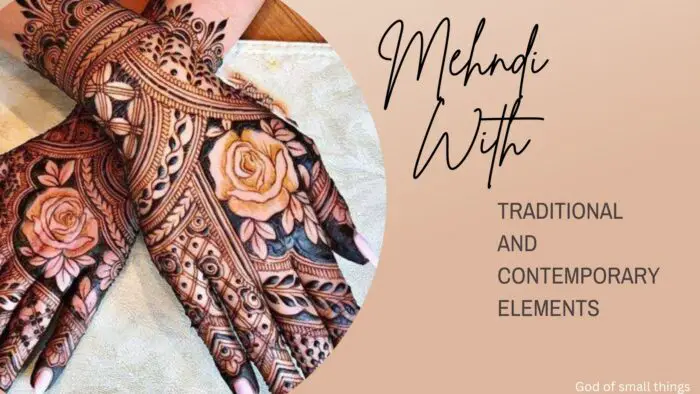
Mehndi, a centuries-old art form originating from the Indian subcontinent, has seamlessly blended traditional and contemporary elements to become a symbol of cultural fusion and self-expression. Rooted in ancient customs, mehndi traditionally involves the intricate application of henna paste on the hands and feet of brides, symbolizing auspiciousness and the bond of matrimony.
However, in today’s world, mehndi has transcended its ceremonial confines and evolved into a captivating form of body art. Modern mehndi artists, often found at festivals and cultural events, have adapted traditional motifs, such as paisleys and peacocks, to create innovative designs that cater to diverse tastes. This harmonious amalgamation of old and new not only preserves the rich heritage of Mehndi but also breathes fresh life into this timeless art. In the contemporary context, mehndi has transcended cultural boundaries, becoming a globally recognized and celebrated form of temporary body adornment.
People from various backgrounds now embrace mehndi as a form of self-expression and artistry. Beyond bridal mehndi, it has found its place in the realm of fashion, with individuals adorning their bodies with mehandi designs as a form of personal style statement. Furthermore, mehndi has taken on a symbolic role in advocating for unity and inclusivity, with artists creating designs that promote messages of harmony and diversity. Thus, mehndi has gracefully navigated the currents of time, intertwining its deep-rooted traditions with the ever-evolving world of contemporary art and self-expression.

